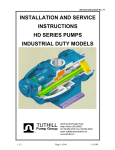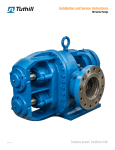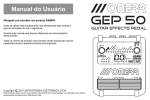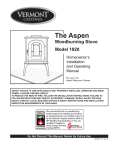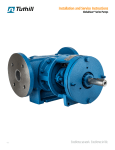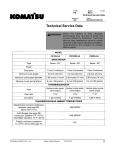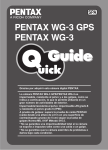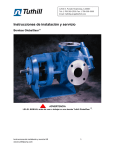Download Installation and Service Instructions ST Series Pumps
Transcript
Installation and Service Instructions ST Series Pumps ! WARNING READ MANUAL before operating or working on a Tuthill ST Series pump. Service Manual 102 Page 2 of 24 4/24/03 Service Manual 102 Table of Contents Page 4 Page 5 Page 5 Page 6 Page 7 Page 8 Page 9 Page 9 Page 10 Page 10 Page 10 Page 10 Page 11 Page 15 Page 18 Page 20 Page 21 Page 21 Page 23 Page 23 Page 24 Introduction General Description Pumping Principle Modular Design Parts Interchangeability Installation Lubrication Requirements Recommended Lubricants Minor Adjustments Simple Efficiency Improvement Packing Adjustment Relief Valve Adjustment Pump Disassembly Pump Assembly End Clearance Adjustment Relief Valve Disassembly Relief Valve Assembly Troubleshooting Torque Specifications Material Returns Tuthill Contact Information Page 3 of 24 4/24/03 Service Manual 102 Introduction The ST Series pumps have been designed and manufactured to provide years of service under normal operating conditions. Illustrations used in this manual are for reference purposes only. Consult the factory or an authorized Tuthill distributor for proper part identification. When ordering replacement parts, provide as much detail as possible to ensure correct parts are provided. Details should include the full model number (15-18 digits), serial number, name of part, part number (if known) and part material. The materials furnished for each pump are selected to suit individual applications. This service manual is also available at www.tuthillpump.com ! WARNING Failure to follow these instructions could result in serious bodily injury or death. Do not attempt to work on any Tuthill pump installation before completing the steps below. Disconnect the drive so that it cannot be started while work is being performed. Review the Material Safety Data Sheet (MSDS) applicable to the liquid being pumped to determine its characteristics and the precautions necessary to ensure safe handling. Vent all pressure within the pump through the suction or discharge lines. All Tuthill pumps contain residual hydraulic oil from the factory production test. Determine if this is compatible with the fluid you are pumping. If the fluid is incompatible, then the pump must be fully flushed prior to use. If the pump is to be operated at elevated temperatures, the pump should be brought up to operating temperatures gradually. Rapid or sudden introduction of liquids at elevated temperatures into the cold liquid chamber of the pump could cause damage to pump externals, seals or other internal parts. Do not run the pump dry. Failure to comply with this could cause severe damage to the internal seal, bushings and/or metal parts. Pump needs to be earthed separately to avoid a buildup of electro-static charge. Page 4 of 24 4/24/03 Service Manual 102 General Description PUMPING PRINCIPLE: The ST Series pumps use the internal gear design pumping principle (see Figure 1) to perform the positive-displacement pumping action desired. Thus, the pump has only two moving parts, the rotor and idler gear. Figure 1 – Internal Gear Pumping Principle Pumping action is based on a rotor, idler gear and crescent-shaped partition cast integral with the cover. Power applied to the rotor is transmitted to the idler gear with which it meshes. The space between the outside diameter of the idler and the inside diameter of the rotor is sealed by the crescent. As the pump starts, the teeth come out of mesh, increasing the volume. This creates a partial vacuum, drawing the liquid into the pump through the suction port. The liquid fills the spaces between the teeth of the idler and the rotor and is carried past the crescent partition through the pressure side of the pump. When the teeth mesh on the pressure side, the liquid is forced from the spaces and out through the discharge port. Page 5 of 24 4/24/03 Service Manual 102 MODULAR DESIGN: The Modular Design concept (see Figure 2) allows for simplified in-line repairs without disturbing the piping or coupling alignment. For more information, consult the Tuthill website or your authorized Tuthill distributor. Figure 2 – Modular Design Page 6 of 24 4/24/03 Service Manual 102 PARTS INTERCHANGEABILITY: Figure 3 – Parts Interchangeability part name ST3 ST6 ST9 ST15 ST30 pump size ST50 ST80 ST135 ST225 ST275 ST350 ST550 relief valve assembly housing cover/pin assembly bracket/bushing assembly bracket bushing idler/bushing assembly idler bushing rotor/shaft assembly mechanical seal or packing gland bearing carrier bearing caps ball bearing Table 1 – Parts Interchangeability Page 7 of 24 4/24/03 Service Manual 102 Installation For optimum pump performance the suction line must be at least as large as the corresponding pump port. It should be as short as possible in order to avoid excessive pressure drops and must be airtight. Locate the pump as close to the source of supply as conditions permit and if possible, below the level of the liquid in the reservoir. When necessary to locate the pump in a pit, provisions should be made to safeguard against flooding. When handling high viscosity liquids, the speed of the pump must be reduced and the size of the inlet lines increased to prevent cavitation. Refer to the NPSHr data for the pump. Pumps should be filled with liquid at installation and should never be allowed to run dry. The placement of a strainer on the suction side of the pump will restrict any solids or abrasives from entering the pump, which could cause internal damage. Under no conditions should the pump be used to support external piping loads (weight or expansion). Piping and other equipment should be independently supported. Piping strain can result in misalignment, hot bearings, worn couplings, vibration, etc. It is important that the piping used be clean and free of chips and scales. The discharge line must be designed with the maximum pressure rating of the pump in mind. Excessive pressure could cause damage to your motor and/or pump. If a pressure relief valve has not been supplied with the pump, some other means of pressure protection must be utilized. This could include in-line safety valves, pressure shutdown switches or other similar devices. Pumps shipped from the factory with relief valves have the relief valve set at full by-pass at the factory on 150 SSU (33 CST) oil at our factory production test speeds. Field adjustments will be required to meet the actual application requirements. Pumps shipped from the factory with relief valves are assembled for clockwise or counterclockwise rotation as originally specified. If you want to change rotation, the relief valve assembly must be removed and turned 180°. The adjusting screw must always point toward the suction line. Every pump installation should have a good foundation. Its structure should be sufficiently strong to hold the pump rigid and to absorb any strain or shock that may be encountered. The installation should be leveled, checked for proper piping alignment, and then fastened securely. The alignment should be rechecked after the pump’s temperature has reached its operating temperature. Direct drive through a traditional flexible coupling is recommended. However, do not expect the coupling to compensate for misalignment. Contact the coupling manufacturer to determine the maximum amount of misalignment that the coupling can be subjected to. Never operate the pumps without all the guards in place. Pumps operating with bi-directional rotation must have pressure relief devices installed on both sides of the pump. Page 8 of 24 4/24/03 Service Manual 102 Lubrication Requirements OUTER BEARING: The standard outer bearings are maintenance-free. They are greased and sealed by the manufacturer. Optional high temperature outer bearings must be re-lubricated at least every 250 hours or 30 days. BRACKET BUSHING: Bracket bushings that do not have grease fittings are fully lubricated by the pumped fluid and are maintenance-free. Bracket bushings that are provided with grease fittings must be re-lubricated at least every 500 hours or 60 days. IDLER BUSHING: Idler bushings that are used with standard solid idler pins are fully lubricated by the pumped fluid and are maintenance-free. Idler bushings that are used with optional greasable idler pins must be re-lubricated at least every 500 hours or 60 days. Recommended Lubricants Recommended Temperature Range Minimum Maximum Deg. F Deg. C Deg. F Deg. C -25 -32 350 177 -25 -32 350 177 Description Manufacturer Grade standard grease Lubriplate Mobil 1200-2 Mobilith AW 2 Lubriplate HIGH-TEMP 40 4 500 260 Lubriplate Mobil Lubriplate Mobil MAG-1 Mobiltemp SHC 32 FGL-2 Mobilgrease FM 102 -60 -60 10 10 -51 -51 -12 -12 200 200 350 350 93 93 177 177 high temp grease low temp. grease food grade grease NOTE: This lubrication data is only intended as a guide. Some applications may have different lubrication requirements, depending on actual conditions. Table 2 – Recommended Lubricants Page 9 of 24 4/24/03 Service Manual 102 Minor Adjustments SIMPLE EFFICIENCY IMPROVEMENT: The efficiency of the pump may decrease after considerable use as a result of wear. If performance deteriorates below acceptable levels, it may be moderately improved by reducing the end clearance between the rotor and cover (See “End Clearance Adjustment” procedure). If this does not improve performance to an acceptable level, then further repair work may be necessary. PACKING ADJUSTMENT: ! WARNING Packing is designed to leak. Therefore, when pumping hazardous liquids, a mechanical seal is recommended to minimize any potential source of leakage that could result in a hazardous condition. Pumps with packing will require periodic adjustment. To accomplish this, gently and evenly tighten the packing gland nuts, which will further compress the packing. Do not over-tighten. Packing is designed to keep leakage to a slight weep. Normally 2-3 drops per minute is acceptable. If excessive leakage persists after complete adjustment, consider re-packing the stuffing box or using another packing type. SAFETY RELIEF VALVE PRESSURE ADJUSTMENT (See Figure 8): The safety relief valves supplied on ST Series pumps are provided with springs that can be adjusted for various settings. Factory setting on all valves is 100 psi (6.9 bar) full by-pass, unless another setting was specified at time of order. This setting will vary depending on liquid viscosity and pump speed. If it must be changed from this factory setting, due to your operating conditions, the following procedure is used: 1. Place a pressure gauge on the pump discharge line as close as possible to the pump in order to obtain accurate readings. There must be no restrictions between the gage and pump. The pump housing has a tapped opening in the port area that is the best location for this gage. 2. Remove the RV cap and gasket to expose the adjusting screw. 3. Loosen the jamnut. 4. Start the pump running. 5. Slowly restrict the discharge line, while observing the pressure gage. Stop immediately if the pressure rises above a safe level. Page 10 of 24 4/24/03 Service Manual 102 6. With the discharge line fully closed, the gauge will read the full by-pass pressure setting for the current speed and viscosity. Do not leave the discharge line closed for a long time, since the fluid temperature will rise rapidly. 7. Adjust the valve adjusting screw to obtain the desired full by-pass setting. Tighten the screw to increase the setting, and loosen it to reduce the setting. 8. Once set, reopen the discharge line. 9. This setting should be 15 to 25 percent above normal operating pressure presented by the system to ensure the valve does not operate during normal use. ! CAUTION If there is some other flow control device present in the system that will vary the system pressure, the relief valve setting should be set above this pressure to ensure the valve does not function during normal use. 10. Tighten the jamnut. 11. Install the RV cap and gasket. Disassembly Procedure Should it be necessary to remove the pump from service for periodic inspection of components and/or a major repair, the following steps should be taken. ! WARNING Failure to follow these instructions could result in serious bodily injury or death. Do not attempt to work on any Tuthill pump installation before completing the steps below. Only authorized personnel who are familiar with the repair of mechanical products should perform the necessary repair work. You must familiarize yourself with the entire contents of this manual prior to performing any work Disconnect the drive so that it cannot be started while work is being performed. Review the Material Safety Data Sheet (MSDS) applicable to the liquid being pumped to determine its characteristics and the precautions necessary to ensure safe handling. Vent all pressure within the pump through the suction or discharge lines. Ensure that the pump has cooled a safe temperature prior to performing any work on the pump. Page 11 of 24 4/24/03 Service Manual 102 1. SAFETY FIRST! Only authorized personnel who are familiar with the repair of mechanical products should perform the necessary repair work. You must familiarize yourself with the entire contents of this manual prior to performing any work. 2. REMOVE THE PUMP FROM BASE: The pump can be removed from the base for service or it can be disassembled without disturbing the housing, provided a spacer coupling was originally installed. 3. REMOVE SAFETY RELIEF VALVE: If the pump has a safety relief valve mounted on it, remove it by loosening the screws that mount it to the housing. 4. REMOVE PUMP COVER: Prior to removing the cover, the general position should be marked in relationship to the housing. Once done, remove the cover screws and the cover. ! WARNING When removing the cover, the idler gear will generally stay on the pin. Avoid tilting the cover downward as the idler may slide off, causing injury or damage. 5. REMOVE THE COVER GASKET: If a new gasket is not available, reuse of the original gasket is acceptable, provided it is not torn or otherwise damaged. 6. REMOVE THE IDLER FROM THE PIN: If the idler gear is still on the cover, check for excessive wear between: − the pin and bushing, − the idler and cover crescent, − idler width and crescent height. Any visible signs of excessive wear will require replacement of the cover/pin assembly and/or the idler and the bushing. If only the bushing shows signs of minor wear, it should be replaced. Acceptable bushing clearances are shown in Table 3 (for pumps with standard clearance only) pump size ST3 ST6 ST9 ST15 ST30 ST50 ST80 ST135 ST225 ST275 ST350 ST550 0.0010 0.0010 0.0015 0.0015 0.0015 0.0020 0.0020 0.0025 0.0035 0.0040 0.0040 0.0050 acceptable clearance inch mm - 0.0040 0.025 - 0.0040 0.025 - 0.0060 0.038 - 0.0070 0.038 - 0.0070 0.038 - 0.0080 0.051 - 0.0080 0.051 - 0.0090 0.064 - 0.0090 0.089 - 0.0100 0.102 - 0.0100 0.102 - 0.0120 0.127 - 0.102 0.102 0.152 0.178 0.178 0.203 0.203 0.229 0.229 0.254 0.254 0.305 Table 3 – Idler Bushing Clearances Note: Many Tuthill pumps are provided with non-standard clearances for use with highviscosity or high-temperature fluids. Consult the factory for clearances of these pumps. 7. REMOVE THE DRIVE MODULE ASSEMBLY FROM HOUSING: If service is being completed with the housing still mounted to the baseplate, you must first remove the spacer from the spacer coupling. Remove the screws that hold the drive module assembly to the housing. Page 12 of 24 4/24/03 Service Manual 102 The drive module assembly can then be pulled from the housing as a single unit. 8. REMOVE THE OUTER BALL BEARING: Remove the two screws that hold the inner bearing cap in place and move the inner bearing cap towards the bracket. (ST225 and ST550 sizes only) Remove the screws that attach the bearing carrier to the bracket. Remove the bearing carrier and outer bearing cap as a single unit. Note: If dirt or rust has gotten between the bearing carrier and the ball bearing outer race, then the bearing carrier may be difficult to remove. Remove the bearing locknut and lockwasher. Remove the bearing from the shaft, using a bearing-puller or other appropriate tool. There is a slight press-fit between the shaft and bearing. 9. REMOVE THE SEAL OR PACKING: 9A. Pumps with packing • Remove the gland nuts. • Remove the gland. • Remove the packing. • The rotor and bracket can now be separated. 9B. Pumps with single seal behind the rotor (In-Board location – See Figure 4) • Remove the bracket. • Remove the seal head from the shaft, directly behind the rotor head. • Remove the seal seat from inside the bracket. Figure 4 – Single Seal in In-Board Location Page 13 of 24 4/24/03 Service Manual 102 9C. Pumps with single seal behind the bushing (Out-Board location – See Figure 5) • Remove the gland screws. • Remove the gland and gland gasket. • Remove the seal head from the shaft. • Remove the seal seat from the gland. • Remove the snap-ring from the shaft. • The rotor and bracket can now be separated. Figure 5 – Single Seal in Out-Board Location 9D. Pumps with cartridge seal • Consult the separate seal instructions provided with the pump. 10. CLEAN AND INSPECT: Clean all parts and inspect for signs of excessive wear or scoring and replace if necessary. Any signs of excessive wear between the bracket bushing and shaft may also cause housing wear. This should be checked. If only the bracket bushing shows signs of minor wear it should be replaced. Acceptable bushing clearances are shown in Table 3 for pumps with standard clearance only) pump size ST3 ST6 ST9 ST15 ST30 ST50 ST80 ST135 ST225 ST275 ST350 ST550 0.0010 0.0010 0.0010 0.0010 0.0010 0.0010 0.0010 0.0030 0.0030 0.0040 0.0040 0.0045 acceptable clearance inch mm - 0.0045 0.025 - 0.0045 0.025 - 0.0050 0.025 - 0.0050 0.025 - 0.0050 0.025 - 0.0060 0.025 - 0.0060 0.025 - 0.0080 0.076 - 0.0080 0.076 - 0.0090 0.102 - 0.0090 0.102 - 0.0100 0.114 - 0.114 0.114 0.127 0.127 0.127 0.152 0.152 0.203 0.203 0.229 0.229 0.254 Table 4 – Bracket Bushing Clearances Note: Many Tuthill pumps are provided with non-standard clearances for use with highviscosity or high-temperature fluids. Consult the factory for clearances of these pumps. Page 14 of 24 4/24/03 Service Manual 102 Reassembly Procedure Tuthill quality replacement parts are available through your authorized Tuthill distributor. Use of parts not manufactured by Tuthill may void your warranty. Prior to reassembly, ensure that all items are cleaned thoroughly and free of any metal burrs. 1. INSERT NEW IDLER BUSHING (if necessary): 1A. Bronze or standard carbon bushings: • Insert the new bushing with the assistance of a hand arbor press. • Ensure that the bushing does not protrude beyond the surface of the idler on both faces. ! CAUTION Special care must be taken during the insertion of carbon bushings. Ensure that the bushing diameter and idler bore are parallel, as any misalignment during insertion may cause cracks. The bushing should be installed using the side of the bushing with the chamfer. Once insertion starts DO NOT STOP until the bushing is in proper position. Starting and stopping can result in cracked bushings. 1B. Tungsten carbide or high-temperature carbon bushings: • Heat the idler gear evenly to about 400°F (204°C). • Set the heated idler gear on a flat surface. • Drop the bushing into the idler gear; making certain that the bushing does not protrude beyond the surface of the idler on both faces. • Allow the idler to air-cool to room temperature. ! WARNING Wear heat-resistant gloves when handling hot components. 2. INSERT NEW BRACKET BUSHING (if necessary): 2A. Bronze or standard carbon bushings: • Insert the new bushing with the assistance of a hand arbor press. Always install the bushing from the chamfered end of the bracket. 2B. Tungsten carbide or high-temperature carbon bushings: • Heat the bracket evenly to about 400°F (204°C). • Set the heated bracket on a flat surface. Most brackets have a lip inside the bushing bore that will keep the bushing properly located in the bracket. If there is no lip, then use a spacer block to properly locate the bushing (see Figure 6). • Drop the bushing into the bracket. • Allow the bracket to air-cool to room temperature. Page 15 of 24 4/24/03 Service Manual 102 Figure 6 – Inserting Bracket Bushing 3. INSTALL PACKING OR SEAL: 3A. Pumps with packing • It is always good practice to install new packing during a complete rebuild. New packing sets are available from an authorized Tuthill distributor. • Slide the bracket over the rotor shaft. • Install and seat each ring into the bracket stuffing box and stagger cut joints from one side of the shaft to the other. • Loosely install the gland, using the gland studs, nuts and washers. The packing will be adjusted on-site. 3B. Pumps with single seal behind the rotor (In-Board location – See Figure 4) ! CAUTION The highly polished seal faces should not be touched during the assembly process as any minor scratch could result in leakage once in service. • • • • • It is always recommended to replace the shaft if scoring is present. If the old one is being reused, lightly polish the shaft, in order to remove minor defects. Place the seal head on the rotor shaft. A light lubricant will assist. If the pump has a spacer between the seal and the rotor head, make sure to re-use the spacer. If the seal head has setscrews, tighten them once the seal head is properly located. Insert the seal seat into the bracket bore. If the bracket has an anti-rotation pin, make sure the pin is aligned with the slot in the seal seat. A lip seal is used to keep dirt and contamination away from the bracket bushing grease. If this seal is damaged, it must be replaced. Always position the lip seal with the lip facing outward. This will allow old grease to be displaced through the lip seal during re-greasing. Slide the bracket over the rotor shaft. Page 16 of 24 4/24/03 Service Manual 102 3C. Pumps with single seal behind the bushing (Out-Board location – See Figure 5) ! CAUTION The highly polished seal faces should not be touched during the assembly process as any minor scratch could result in leakage once in service. • • • • • • It is always recommended to replace the shaft if scoring is present. If the old one is being reused, lightly polish the shaft, in order to remove minor defects. Slide the bracket over the rotor shaft. Install the snap ring into the groove on the rotor shaft. Place the seal head on the rotor shaft. A light lubricant will assist. If the pump has a spacer between the seal and the snap ring, make sure to re-use the spacer. If the seal head has setscrews, tighten them once the seal head is properly located. Insert the seal seat into the gland. If the gland has an anti-rotation pin, make sure the pin is aligned with the slot in the seal seat. Install the gland to the bracket, using the gland gasket and gland screws. 3D. Pumps with cartridge seal • Consult the separate seal instructions provided with the new seal. 4. REBUILD DRIVE MODULE ASSEMBLY: Place the rotor and bracket assembly on a flat surface so the shaft points upward. Place the inner bearing cap over the shaft. Press on the new ball bearing onto the shaft, using an arbor press. Ensure that it bottoms out on the shaft step. The bearing must be pressed on the inner race, not the outer race. Pressing on the outer race could damage the bearing. There is a slight press-fit between the bearing and shaft. ! CAUTION Do not use excessive force when pressing the bearing onto the pump shaft, as it could damage the mechanical seal. Install the bearing lockwasher and locknut. After the locknut is tightened, bend one of the lockwasher tabs into the locknut slot, to ensure that the locknut cannot vibrate loose. Slide the bearing carrier onto the bracket. (ST225 and ST550 sizes only) Install the screws that attach the bearing carrier to the bracket. Loosely fit the inner and outer bearing caps to the bearing carrier, using the bearing cap screws. DO NOT tighten the screws at this time. 5. INSTALL DRIVE MODULE TO HOUSING: Place the gasket on the bracket. Page 17 of 24 4/24/03 Service Manual 102 Slide the drive module into the housing and assemble with drive module screws. 6. PLACE IDLER ASSEMBLY ON COVER: Once the idler is on the cover, ensure that it rotates freely. 7. INSTALL COVER AND IDLER ASSEMBLY: Place the gasket on the cover. Tilt the top of the cover away from the pump until the crescent can be fitted into the rotor I.D. Then rotate the idler until its teeth mesh with the rotor teeth. Assemble with cover screws. 8. INSTALL RELIEF VALVE TO HOUSING: Prior to reinstalling the relief valve back onto the pump housing, ensure that the valve is clear of any foreign material and that the flow ports are unobstructed. Place the valve gasket on the housing. Assemble the valve on the pump housing with valve screws. Make certain the adjusting screw of the valve points towards the suction port. ! CAUTION The adjusting screw of the valve must point towards the suction port. 9. ADJUSTMENT OF END CLEARANCE: (See Figure 7) Figure 7 – Setting End Clearance This adjustment is accomplished by adjusting the four bearing cap screws. Tightening the outer bearing cap screws will move the rotor towards the cover, reducing the end clearance. Tightening the inner bearing cap screws will move the rotor away from the cover, increasing the end clearance. Start with both bearing caps loose. Page 18 of 24 4/24/03 Service Manual 102 Determine the required end clearance setting from Table 5. Note: Many Tuthill pumps are provided with non-standard clearances for use with high-viscosity or high-temperature fluids. Consult the factory for clearances of these pumps. Obtain a feeler gage of the required end clearance setting. Insert the feeler gage between the rotor and cover, as shown in Figure 7. The gage can go through either the suction port or the discharge port. If the piping is already installed, then the gage can go through the relief valve ports (with relief valve removed). Slowly tighten the two outer bearing cap screws until the feeler gage is loosely clamped between the rotor and cover. Be careful to keep the bearing cap square to the bearing. Hand-tighten the two inner bearing cap screws. Be careful to keep the bearing cap square to the bearing. Carefully tighten all four bearing cap screws to lock the rotor in place. You should be able to pull the feeler gage out with moderate effort. If you cannot pull the gage out, then the setting is too small. If the gage pulls out freely, then the setting is too large. Re-adjust if necessary. When this adjustment has been completed, check to ensure the shaft will rotate freely by hand. pump size ST3 ST6 ST9 ST15 ST30 ST50 ST80 ST135 ST225 ST275 ST350 ST550 acceptable clearance (iron or steel) inch mm 0.003 0.003 0.003 0.005 0.005 0.007 0.007 0.011 0.011 0.015 - 0.005 0.005 0.005 0.007 0.007 0.009 0.009 0.013 0.013 0.017 0.08 0.08 0.08 0.13 0.13 0.18 0.18 0.28 0.28 0.38 Table 5 – pump acceptable clearance (stainless steel) size inch mm ST3 0.002 - 0.004 0.05 - 0.10 ST6 0.002 - 0.004 0.05 - 0.10 0.13 ST9 0.003 - 0.005 0.08 - 0.13 0.13 ST15 0.003 - 0.005 0.08 - 0.13 0.13 ST30 0.003 - 0.005 0.08 - 0.13 0.18 ST50 0.005 - 0.007 0.13 - 0.18 0.18 ST80 0.005 - 0.007 0.13 - 0.18 0.23 ST135 0.007 - 0.009 0.18 - 0.23 0.23 ST225 0.007 - 0.009 0.18 - 0.23 0.33 ST275 0.011 - 0.013 0.28 - 0.33 0.33 ST350 0.011 - 0.013 0.28 - 0.33 0.43 ST550 End Clearance Values 10. REFIT COUPLING AND GUARD: If you have been able to take advantage of the modular design of this pump, the complete overhaul has been accomplished without removal of the housing from the base plate or piping. Thus, your original coupling alignment should be intact. Refit the coupling and spacer, double-check alignment and complete any final adjustments. Page 19 of 24 4/24/03 Service Manual 102 Safety Relief Valve Disassembly Procedure Tuthill provides safety relief valves on pumps for over-pressure protection only. They are not intended for use as flow control devices or any other similar use. ! CAUTION Continuous operation of the valve results in excessive heat build up within the pumping cavity, which could cause serious internal damage. Figure 8 – Relieve Valve Note the valve position in relation to the housing and suction piping. Ensure that system pressure has been relieved and that the driver has been locked out prior to doing any service work. 1. Remove the RV cap to expose the adjusting screw. 2. Measure and record the length of the exposed amount of the screw. 3. Loosen the jamnut and adjusting screw to relieve initial spring pressure. 4. Remove the adjusting screw, bonnet, gasket, spring guide, spring and poppet from the RV body (See Figure 8). 5. Inspect all parts for wear or damage, in particular the valve seat area. Excessive wear or damage at this surface would be cause for replacement of components. Page 20 of 24 4/24/03 Service Manual 102 Safety Relief Valve Reassembly Procedure 1. Ensure all parts are clean, no foreign matter is in the valve and the ports are unobstructed. 2. Assemble the poppet, spring, spring guide, gasket, bonnet and adjusting screw into the RV body (See Figure 8). 3. Reset the adjusting screw to the original position. 4. Tighten the jamnut. 5. Assemble the RV cap and gasket. Troubleshooting 1. Problem: No fluid is delivered. a. Power is not on. b. Net positive suction head available (NPSHa) is lower than required for the vapor pressure of the liquid pumped. You should calculate NPSHa and redesign piping, if necessary. c. There are leaks in suction line. d. Direction of shaft rotation is incorrect. e. Relief valve setting is too low. Liquid is discharging through the by-pass port. 2. Problem: Capacity is too low. a. There are air leaks in suction line. b. Suction losses are too high. The suction lift is too great or the suction line is too small or too long. This can be detected by installing a vacuum gauge directly at the pump suction. The maximum vacuum at the pump suction should never exceed 15” of mercury. Vaporization caused by higher vacuums will generally result in capacity drop off. Redesign suction conditions. c. Pump speed is too slow. d. Strainer is too small or obstructed. e. Suction pipe or port is not immersed in liquid deep enough f. Piping is improperly installed permitting an air pocket to form in the pump. g. Increased clearances or wear in the pump will sometimes cause the pump to deliver an insufficient supply of liquid. This may be corrected by adjusting the end clearance. A folded gasket or a slight amount of dirt can exaggerate the problem and cause leakage. Page 21 of 24 4/24/03 Service Manual 102 3. Problem: Pump works spasmodically. a. Leaky suction lines. b. Suction conditions vary. c. Air or vapor is in the liquid. 4. Problem: Excessive power draw. a. Pressure is too high. b. Liquid is more viscous than originally expected. c. Suction or discharge line is obstructed. d. There is insufficient horsepower. e. There are mechanical defects: i. Drive shaft and pump are misaligned. ii. Pump is binding due to insufficient end clearance. iii. Pump shaft is bent. iv. There is misalignment within pump due to bad piping or poor installation, causing strain or distortion. 5. Problem: Pump is noisy. a. Pump is cavitating due to inadequate suction conditions. b. There is misalignment of coupling. c. Coupling is set too close to pump. d. There is vibration of the pump due to a worn or bent shaft. e. There are air leaks on suction side of pump or air entrainment in the fluid. 6. Problem: Pump leaks. a. Bolts need tightening, allowing gaskets or o-rings to leak. b. Gaskets or o-rings are damaged. Note: Packings are designed to leak. Leakage should be at a rate that will prevent excessive heating on the bracket at the packing area. Page 22 of 24 4/24/03 Service Manual 102 Torque Specifications Screws & Nuts Fastener Size M6 M8 M10 M12 Nut Size N-05 N-06 N-07 N-08 foot-pounds 6 9 14 21 30 40 55 65 Newton-meters 8 12 19 28 41 54 75 88 Bearing Locknuts Pump Size foot-pounds GG15-30 50 70 GG50-90 75 95 GG120-210 100 - 130 GG250 120 - 150 Newton-meters 68 95 102 - 129 136 - 176 163 - 203 Table 6 – Torque Specifications Material Returns If it becomes necessary to return a pump to the factory, a Return Goods Authorization (RGA) must be obtained from either your local Authorized Distributor or our Alsip plant. No RGA can be issued until a completed Material Safety Data Sheet (MSDS) has been forwarded to our Alsip plant and return of the pump has been approved. • • Tuthill pumps are precision-built and must be handled with care. Pumps must be drained of all fluid and the ports plugged to prevent foreign material from getting into the pump. Pumps must be packaged securely to prevent damage while in transit. Page 23 of 24 4/24/03 Service Manual 102 Tuthill Contact Information If additional information is required to facilitate operation or maintenance, contact the authorized Tuthill distributor shown below. Information on Tuthill contacts can also be obtained at www.tuthillpump.com. Your Authorized Tuthill Distributor is: Page 24 of 24 4/24/03


























